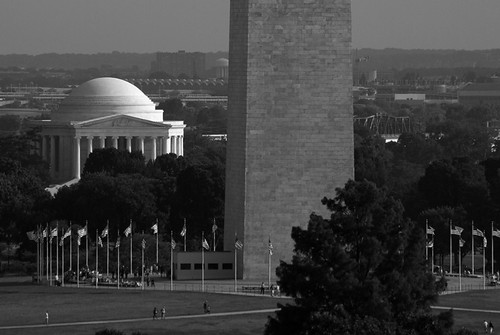
‘TJ, from above’
courtesy of ‘philliefan99’
It’s officially tourist season here in DC, and our once-serene monuments and memorials are again overrun with school groups in matching t-shirts and families pushing strollers the size of SUVs. They’re here to see the monuments and memorials all over the city, and to educate future generations about the founding of our country and important historic events. But there are so many myths about the monuments and memorials in the District that can’t possibly be true, so I set out to bust some of them, just in time to set those tourists straight. Read on to find out whether there’s an extra hand of God on the Iwo Jima memorial, whether the number of horse’s hooves on the ground of a statue relates to how a person died, and what’s really buried beneath the Washington Monument.

‘Reach For the Sky’
courtesy of ‘maxedaperture’
Myth #1: There’s a 13th hand on the Iwo Jima Memorial, but there are only 6 soldiers depicted. The extra hand is meant to symbolize the hand of God.
Legend has it that the Marine Corps War Memorial, commonly referred to as the Iwo Jima Memorial, shows 13 hands. The statue was based off Joe Rosenthal’s iconic photo, Raising the Flag Over Iwo Jima, which we can assume just depicted twelve hands. So did sculptor Felix de Weldon add in a thirteenth hand to show divine intervention?
Definitely not. Go down and count for yourself, there are only twelve hands. Despite this, it’s a very persistent myth–but even the sculptor himself has denied it, saying, “Thirteen hands. Who needed 13 hands? Twelve were enough.” Veteran Tom Miller has even written a booklet dispelling the myth, called “The Iwo Jima Memorial & the Myth of the 13th Hand.” Myth busted.

‘Andrew Jackson’
courtesy of ‘kimberlyfaye’
Myth #2: The number of hooves in the air on equestrian statues tells you how the person died. Two hooves in the air means the person died in battle, one hoof means the person was injured in battle, and all four hooves on the ground means the person survived battle unharmed.
This legend, sometimes called the Hoof Code, was something I grew up hearing from my parents, and it’s definitely made its way into tourist guidebooks everywhere. Lucky for us, Washington is home to the highest concentration of equestrian statues in the country, so it’s pretty easy to go out and check to see if the Hoof Code applies universally. And does it?
Nope. Snopes actually busted this one already, finding that only ten of the 30 equestrian statues in the city follow the Hoof Code. Take Andrew Jackson’s statue shown above– the Hoof Code would tell us that he died in battle, but he actually died at the age of 78 of chronic tuberculosis. Take a look at some other equestrian statues from around the city, and you’ll see– this myth is definitely busted.

‘wESCHERington Monument II’
courtesy of ‘ameschen’
Myth #3: As made famous in The Lost Symbol, there’s a bible buried beneath the Washington Monument.
When The Lost Symbol came out last year, everyone raced to figure out what secrets were hidden in the District. And after all the build-up (SPOILER ALERT!), the lost symbol turns out to be a bible buried beneath the cornerstone of the Washington Monument. It’s one of those hidden-in-plain sight revelations that Dan Brown’s books are known for. But is there really a bible buried underneath the cornerstone of the Washington Monument?
Yes, among other things. Snopes again comes to the rescue on this myth, listing all the items that were buried in the recess of the cornerstone of the Washington Monument, including: several atlases and reference books, multiple guides to Washington DC and the Capitol, Census records from 1790 to 1848, various poetry, the Constitution, and the Declaration of Independence. All told, there were dozens of items placed in the cornerstone, and the bible was one of them. So yes, the bible is buried underneath the Washington Monument, but it’s just one of dozens of items there.
So the final tally is 2 myths busted and one myth confirmed. And these are just a few of the countless myths about monuments and memorials in the District, so stay tuned for another Monumental Mythbusing in the future. Now go forth and correct all the tourists you hear propagating these myths!
I love the hoof theory… there’s a favorite statue of mine in downtown Denver of a cowboy on a bucking bronco- only one hoof is on the ground. Following the hoof theory, this must mean this particular cowboy was fired into space by a cannon…
Why is there no “J” street?
Although there may not be 13 hands on the Iwo Jima Memorial, I believe there is a disembodied hand. In the above photo, it’s on the left side, grasping the wrist of another soldier. It doesn’t connect to a body.
Don’t ask me how they all add up to 12 though.
I actually asked one of the rangers at the Iwo Jima Memorial about the extra hand, and he got pretty exasperated about it. When he explained it was a myth, I explained where I had heard it from: my high school history teacher (and that’s Gonzaga on Eye Street)! He said it was supposed to be the “hand of the Marine Corps;” as in, the entire Corps works together.
So it’s not just tour books getting it wrong, it’s people who should know better too.
This alis a great little piece, and to the above comment on why there is no j street, it is not because effant didn’t like Andrew Jackson but that the letter I and J are very similar in old script!
http://jstreet.org/
What weak explanation re. the 13th hand. I say it’s not there so it’s not there. Only a concrete count can be definite proof.